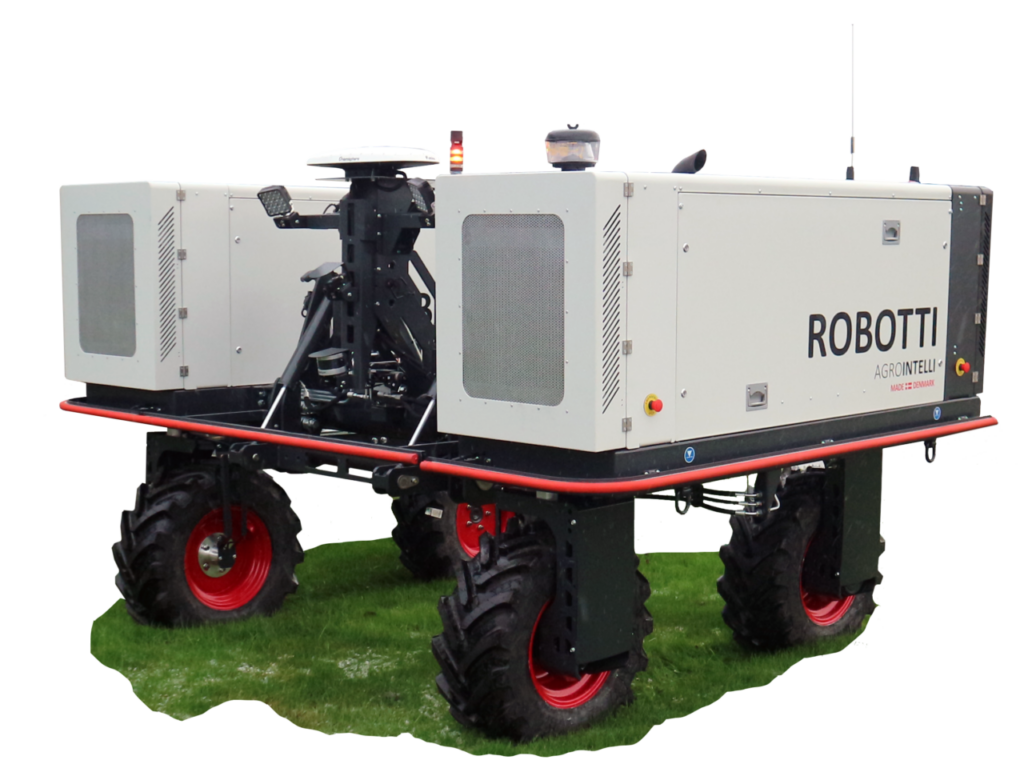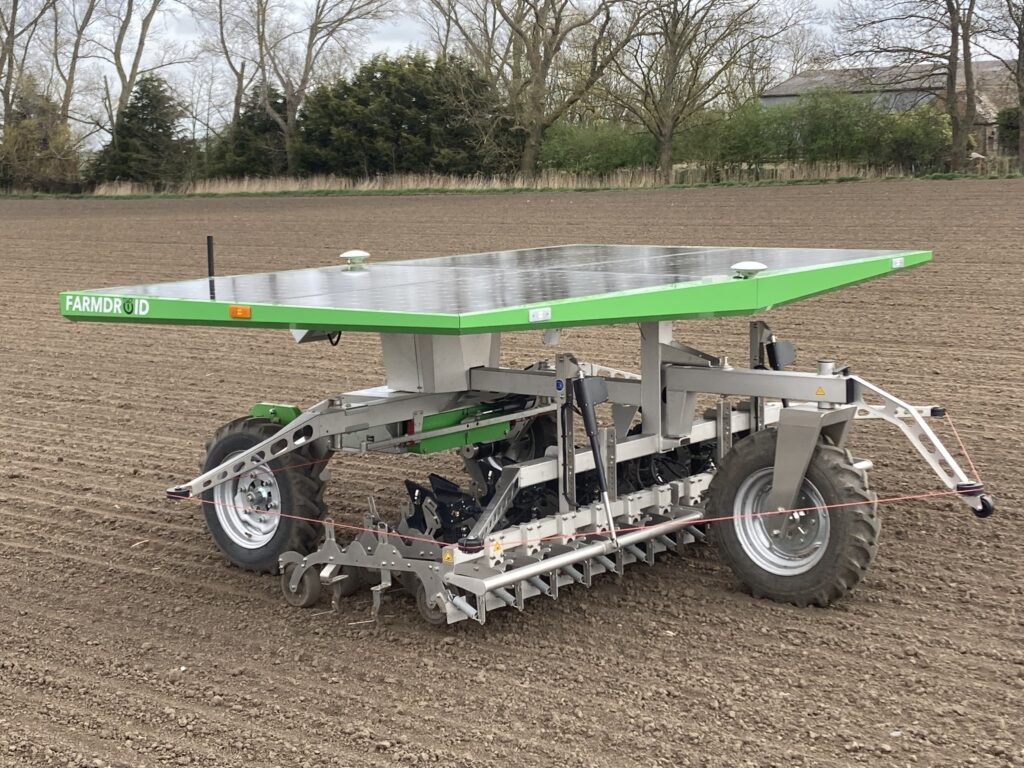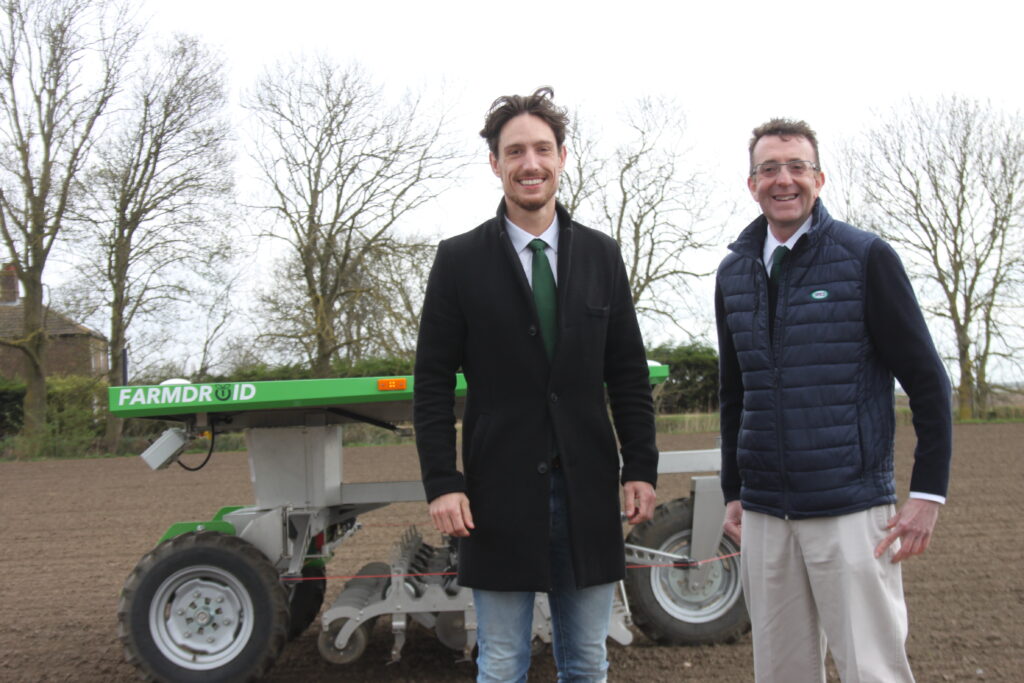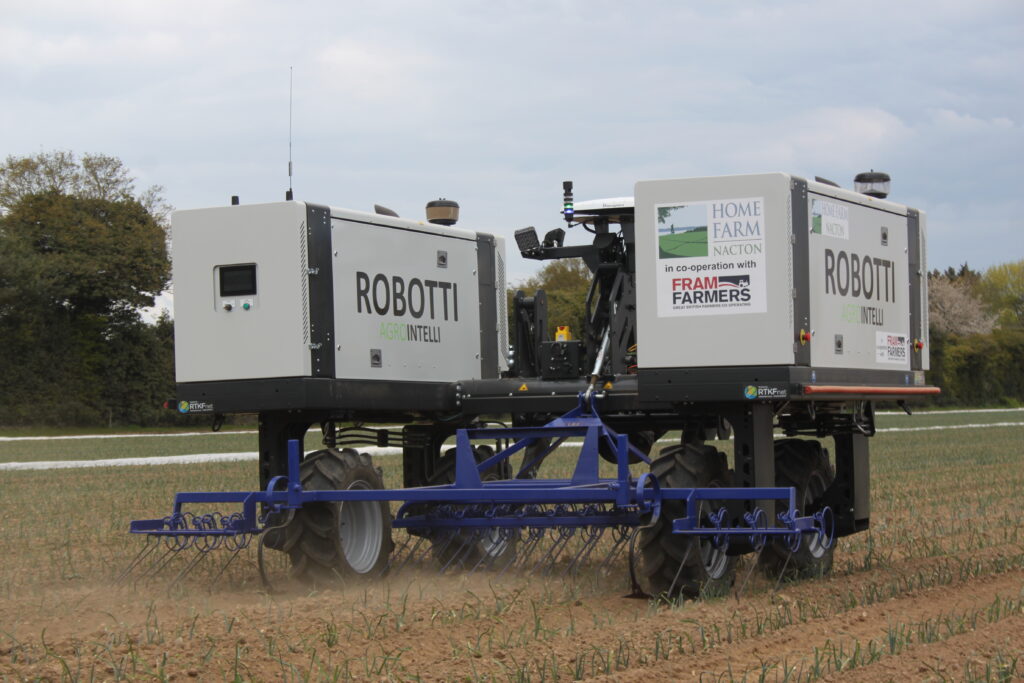Autonomous farm vehicles have moved beyond development projects and prototypes into full commercial production and sale. Tech Farmer assesses the main offerings for the UK farmer.
By Martin Rickatson and Tom Allen-Stevens
Not long ago, autonomous or robotic agricultural vehicles, particularly those for fieldwork, were the stuff of prototype areas on stands at big international shows, or demo zones at field events. The question of market-readiness was something many manufacturers seemed to stall when asked.
Over the past couple of years, though, there has been a shortening of the time to market quoted for such machines from ‘soon’ to ‘now’. From conventionally-engined autonomous vehicles to solar-powered robots, there are a number of units now working on UK farms, particularly those growing precision-sown crops, where the regularity of plant spacings lends itself to automation of field tasks.
From their power sources to the way they put that power to the ground, and the implements they can work with, different products lend themselves to different cropping systems. And while initial autonomous field vehicle developments were targeted chiefly at establishing and weeding precision-drilled row crops, there are now machines available capable of combinable crop land preparation and other tasks.
With skilled staff hard to find and repetitive tasks lending themselves to automation, the attraction of high daily workrates with 24-hour working all stack up in favour of autonomous vehicles. Here are the key options of machines now available which are creeping their way on to UK farms.
Agrointelli Robotti
One of the first machines sold to a UK farm was a Robotti 150D unit from Danish manufacturer Agrointelli, supplied and supported by its UK agent, West Midlands-based Autonomous Agri Solutions.
With two Kubota 75hp diesel engines, one powers the hydrostatic wheel motors and the hydraulics, and the other the PTO. A total fuel capacity of 220 litres is reckoned sufficient for approximately 24 hours’ operation. The Robotti is autonomously controlled with 2.5cm repeatable accuracy by RTK GPS via an onboard computer terminal, to which can be loaded a pre-programmed planned field route map.

Tom Beach, who founded Autonomous Agri Systems with fellow ex-Harper Adams University graduate Jack Wyatt, says Agrointelli’s design deliberately blends concepts with which most farmers will be familiar – such as diesel power and conventional hydraulics – with key autonomous technology principles.
“One of the key tasks for which the machine is suited is continuous light inter-row cultivation of row crops to keep weeds at bay, providing a broader window of opportunity during potentially short spells of good weather,” says Tom.
“By moving surface soil in the early stage of weed growth with guaranteed precision, weeds can be uprooted early before they can affect the crop, and the machine’s light weight means multiple, frequent passes can be made where necessary with little land impact.”
Mapping a field and logging the weeding plan into the software takes a matter of minutes, explains Tom.
“The online Robotti portal provides owners with real-time updates of machine progress, fuel data and images from its cameras, while text alerts notify of any issue with operation, and of job completion.”
Agrointelli has now developed a new Robotti design, the LR, which features a number of updates, says Tom.
“Most significant is a move from twin engines to a single 75hp powerplant, made possible through the development of an updated hydraulic system. This has helped boost fuel capacity to 310 litres, providing up to 60 hours’ run-time, good for around 90ha of weeding, depending on circumstances.
“Retaining conventional engine power means farmers know and understand its maintenance and management, whereas electric power, for example, would require specialist knowledge and support, and batteries don’t offer this sort of run-time or capability. But with regard to emissions and CO₂ neutrality, it is fully biodiesel-compatible.
“There is a full PTO and a 1200kg three-point linkage, and Agrointelli is building partnerships with implement firms including Stanhay Webb, Kverneland, Pöttinger and the German company Kult Kress, although any conventional implement is compatible within reason. Plans are also afoot to extend the machine’s weed control capabilities to include electrical and laser-based systems, for targeted control of larger weeds without soil disturbance. Precision-sown row crops remain its forte, though, and we have worked with Sentry in particular to illustrate the Robotti’s capabilities to carry out the full suite of sowing, hoeing and band-spraying operations through the sugar beet season, for example.”
Interested parties are able to purchase directly from Autonomous Agri Solutions, with finance offered, says Tom.
“However, we have also now developed a model that offers robot as a service (RAAS) as an alternative, for those preferring to rent a machine at a price/ha depending on planned operations and usage level.
“List price of a Robotti LR is around £175,000, or approximately £200,000 with a full suite of equipment including precision drill and weeder suiting an annual 200ha workload. However, we have developed a £35,000/year rental model, a cost that can ultimately be offset at a £25,000 annual reduction against a purchase price, as an option for those who want initially to work out how a Robotti will fit their system before buying.”
Opico FarmDroid
Marketed in the UK by Opico since early 2022, with 16 units now on UK farms, is the Danish designed and built FarmDroid FD20. It was conceived in 2011 on Jens Warming’s family farm, targeting a simpler, cheaper way of inter-row weeding sugar beet.
Joined subsequently by his brother Kristian, and by specialist robotics engineer Esben Østergaard, the three developed an autonomous machine for seeding and subsequent weeding of row crops. This revolved around the principle that by using ultra-high precision RTK placement of seed, recorded placement data could then be used to subsequently weed not just between plant rows, but also between plants in each row, without the need for camera systems. A further principle was harnessing solar energy for propulsion, reckoned to be practical given the relatively low energy requirement of such a machine.

The first production version was shown at Agritechnica 2019, and 12 machines were working on Danish farms by 2020, with an updated model developed by that autumn. Power comes from four solar panels charging two lithium batteries. Two further spare batteries can be charged remotely if required, although charging takes place during daylight operation whatever the light level. 24-hour operation is possible from battery storage of solar-generated power, although dull days can halve this and an optional additional power pack is recommended. Should it run out of power during darkness, the machine simply begins moving again when the sun rises and the solar panels again become active. A rain sensor stops the machine or notifies the user’s app if a certain amount is detected.
Propulsion is via a 400W electric motor on each wheel, and operation is therefore fuel and emission-free, and CO₂-neutral. Farmdroid points out this will particularly aid farmers whose produce buyers are pressuring them to fulfil environmental demands along with crop supply contracts. Electric motors also engage and power the seeding and weeding units.
Steering is via drive motors on the front wheels, which work constantly at different forward speeds to keep the machine running straight. There is a single wheel at the rear, although Opico reports a four-wheel option has become increasingly popular, and early three-wheel models can now also be converted.
The 3.0m FarmDroid can be equipped with four, six or eight precision drill and inter/intra-row cultivation element sets, both developed and manufactured in-house. Although cameras aren’t required for guidance, one unit provides the person monitoring the machine via FarmDroid’s smartphone app with an anytime view of its activity, which also provides operating data and any error message alerts.

Weighing 900kg without attachments, the machine is transported between fields by tractor, and because it operates at less than 1.0 km/hr (working speeds can be set from 450-950m/hr), and is fully equipped with safety stop and smartphone app alert features should it come into close proximity with an object or person, it isn’t subject to any further safety legislation during operation. Farmdroid suggests that, where practical/required, it can be left in the field for the season to make repeated passes, and calculates that despite its sedate pace it has a 6.0ha/24hr potential workrate.
The FD20 is guided around the field perimeter to record the corner points, thereafter setting a geofence from this to recognise the field boundary and set the headlands. In addition, any obstacles, the number of headland bouts and the seed spacing are set at this point. From this, the machine calculates the best working path plan. FarmDroid’s own RTK system works to a repeatable 0.8cm accuracy, using front- and rear-mounted machine-mounted antennas. These communicate with a farm-installed fixed base station which must be within 10km of the field, enabling the FarmDroid to work within 5mm of each seedling between the rows and 20mm in the row.
“If we can seed it, we can weed it,” says Eddie Pedersen, FarmDroid’s sales manager.
“For drilling, once the field parameters are set, it’s simply a matter of programming in the required plant density and spacing, and setting off the machine. Roller disc pairs are followed by a furrow opener that creates a V-shaped slot. The individual six-litre seed hoppers each supply an electrically-driven seed motor. These feed individual seeding discs, with a range of interchangeable units 3D-printed in-house. There are different hole diameters, disc thicknesses and disc diameter.
“The machine remembers where each seed has been placed within a variation of 0.8cm. Once drilling is complete the tool units can be changed over – the seeding units simply flip up and the weeding ones drop down. The FarmDroid can then be set for pre-emergence ‘blind’ weeding soon after drilling, and for repeated passes at intervals in the weeks afterwards. While the weeding wires passively remove weeds between rows, separate active weeding knives interject between each plant, based on the known seed positions.
Harvey Sherwin, Opico’s FarmDroid product manager, says weeding is best done in relatively dry conditions that will cause uprooted weeds to desiccate and die.
“The passive inter-row hoes are constantly engaged with the soil, and when the machine is set up the row width is fixed,” he explains.
“Conversely, the active intra-row hoeing, with the knives moving in and out between plants, can be altered down to 10cm spacing, according to crop type and stage. While vegetable and root crops remain the system’s forte, trials with Bayer are assessing FarmDroid’s capability to establish and early-weed oilseed rape.”
Beyond zero fuel cost and low maintenance, a key advantage of solar power is that the machine’s zero emissions could help growers meet carbon obligations, points out Harvey.
The cost of a four-row FarmDroid is around £70,000, with additional rows at approx £4000 each and about £6000 required for the necessary high-accuracy RTK base station. Opico suggests those costs could be recouped in two years through reductions in labour, herbicide and other machinery costs.
AgXeed AgBot
The AgBot tractors from Dutch firm AgXeed are for those seeking something to automate heavier draft tasks requiring high traction. In England and Wales, tracked and wheeled autonomous AgBots are available from ASC Autonomy, part of precision farming firm AS Communications, while Soil Essentials looks after other UK areas. Andrew Williams, who works alongside AS founder Will Mumford, says the units can be purchased for around £70-85,000 depending on specification.
“The AgBot models, particularly the tracked versions, suit a broader range of tasks than some other autonomous tractor options, and outright purchase suits the needs of most farmers we talk to,” suggests Andrew.

While there’s a three-wheeled design largely aimed at orchard and horticultural rowcrop work, it is the four-wheeled and particularly the twin-tracked AgBot versions that primarily suit arable field tasks.
The four-wheeled 2.055 W4 is powered by a 75hp four-cylinder Deutz engine with 170-litre diesel capacity. An electric drivetrain provides a 0-13.5km/hr speed range, plus optional electric PTO and 55kW/700V electric implement power connection.
Implement operation is more conventionally overseen by an 85 l/min hydraulic system operating at 210 bar with optional load-sensing, feeding up to three double-acting remote valves, a 4.0t rear linkage and 1.5t front hitch.
“Electric drive motors provide the most efficient and controllable transfer of power, but in all other aspects these are essentially standard tractors without cabs,” explains Andrew.
Key differences on the twin-tracked AgBot T2 include more than double the power output, with 156hp available, and a doubling of both front and rear hitch capacities. Available track widths span 300-910mm, and track spacing can be adjusted between 1800-3000mm or 1800-3200mm, depending on chassis and track type specified.

As with other manufacturers’ autonomous tractor developments, work planning, monitoring and control is via an internet portal and app, and tasks can be pre-planned on a PC. A full suite of sensors ensure the safety of the machine and anything around it.
“We are working with all options to get machines onto farm, including direct sales where possible, working with a finance company for finance and leasing agreements, and are looking at hire ideas.
“With three years’ warranty and servicing, a T2 tracked machine costs around £320,000. It’s a challenge to change mindsets, but with the AgBot T2 tracked machine’s capabilities, we see scope for some farmers to consider changing a large tracked tractor for perhaps a trio of T2 units, overcoming labour challenges and boosting productivity.”
Weed-mapping robot set to microspray
It’s been a year of ups and downs for the Small Robot Company (SRC), the British agritech start-up part-owned by farmers, with farmers also helping develop the technology. Its autonomous Tom scouting robot now has the ability to detect and map blackgrass in a wheat crop. The company has also taken its PerPlant concept forward, developing the ability to microspray for pests and diseases.

Rather than buy the robot, the company is developing Farming as a Service (FaaS) whereby a ‘pod’ is set up to service a number of local growers, who sign up to a fixed number of visits over the season.
A pilot version of this ran during the 2022/23 cropping season with twelve farmers around its base in Wiltshire. Each committed 20ha to the trial and received four visits: before crop emergence (detecting green on brown), mid-tillering, post-vernalisation in February and before the canopy closed in around April.
While the service delivers plant density information, it’s the weed detection on a per-plant basis that may have more value. During the season, the SRC team developed a detection model for early stage grassweeds, claimed to perform well against an expert agronomist.
SRC says it is the “only company in the world” capable of detecting and mapping grassweeds. The service gives farmers the ability to accurately track blackgrass populations, and the data can feed into a sprayer with individual nozzle or section control to deliver herbicide savings. While few growers would rely on the service to spot spray grassweeds, it can be used to focus application of more expensive herbicide stacks, according to the pilot farmers.
The Tom scouting robot itself is now on version 4, with a more rigid boom, an upgrade to its eight cameras and a modular design. This platform makes it a more robust and flexible tool to carry payloads and complete various actions in the field. Along with scouting, Tomv4 is designed to carry out micro-spraying or non-chemical weeding, making it ready to take the next step to precision application.
SRC has also developed its Wilma AI system, providing field-scale actionable insights at a per-plant level and allowing spray technology to be optimised to reduce chemicals. This PerPlant data enables farms to transition to regenerative practices safely and profitably, says the company.
Working with partners, SRC has just completed a collaborative two-year project with funding from Innovate UK to develop a prototype for robotic microspraying for pests and diseases. The design of sprayers, and algorithms for pest detection was led by Strathclyde University, while SRC provided the robotic hardware and integrated the algorithms into its Wilma AI system. Agri-EPI aided the analysis, development, and optimisation of data collection.
With the sprayer boom design set for completion this year, the robotic platform is poised for commercial field trials, according to SRC CEO Ben Scott-Robinson. “Microspraying could be game-changing for the industry. Pressure is increasing from regulators, leaving farmers short of options. Precision spraying could enable a new generation of spot-treatment chemicals, reduce costs, and significantly reduce the impact on biodiversity.”
Commercial roll-out of SRC’s services suffered a setback earlier this year when a potential investor pulled out, leaving the company dangerously close to having to call in receivers. A crowd-funding campaign successfully raised £1.6M and SRC has reached heads of terms with another backer.
The company is looking to set up franchise agreements with partners to roll out the pods, with the first franchise expected to be trialled in September 2024. Full commercial rollout is set to get underway in the 2024/25 cropping season.




